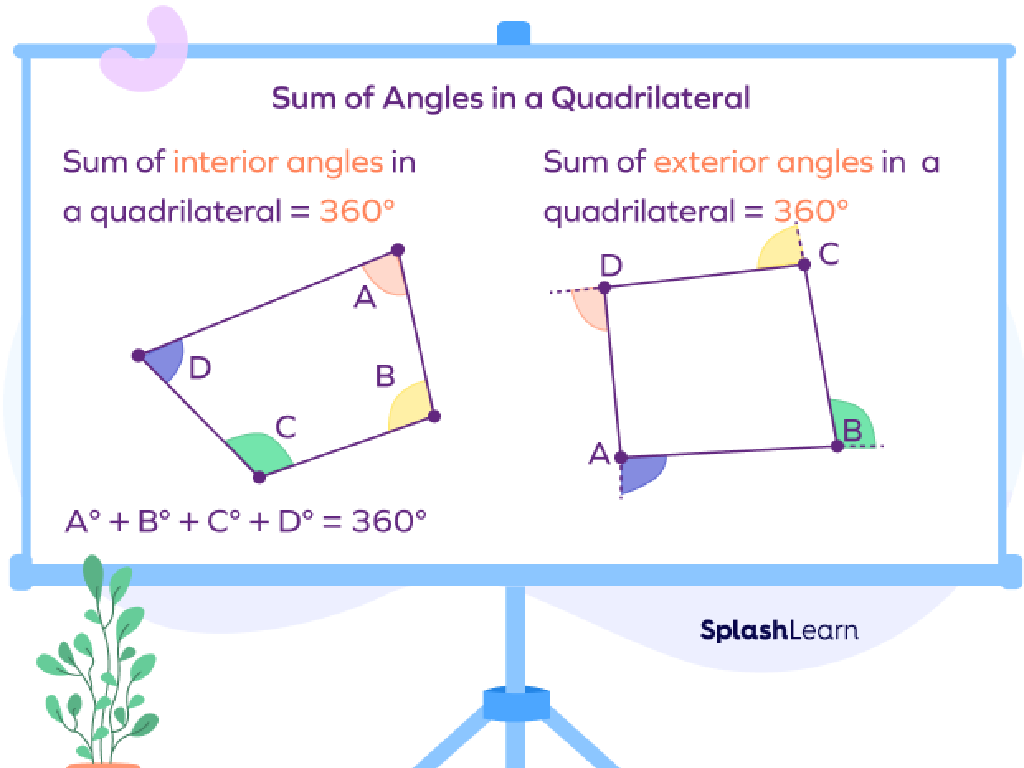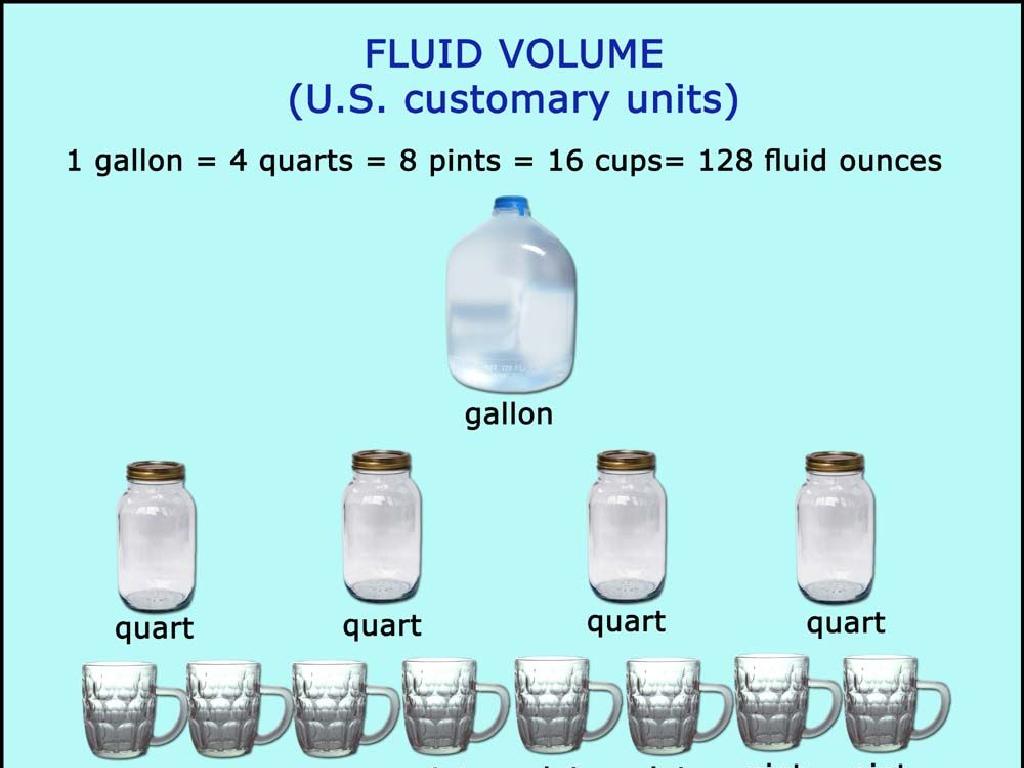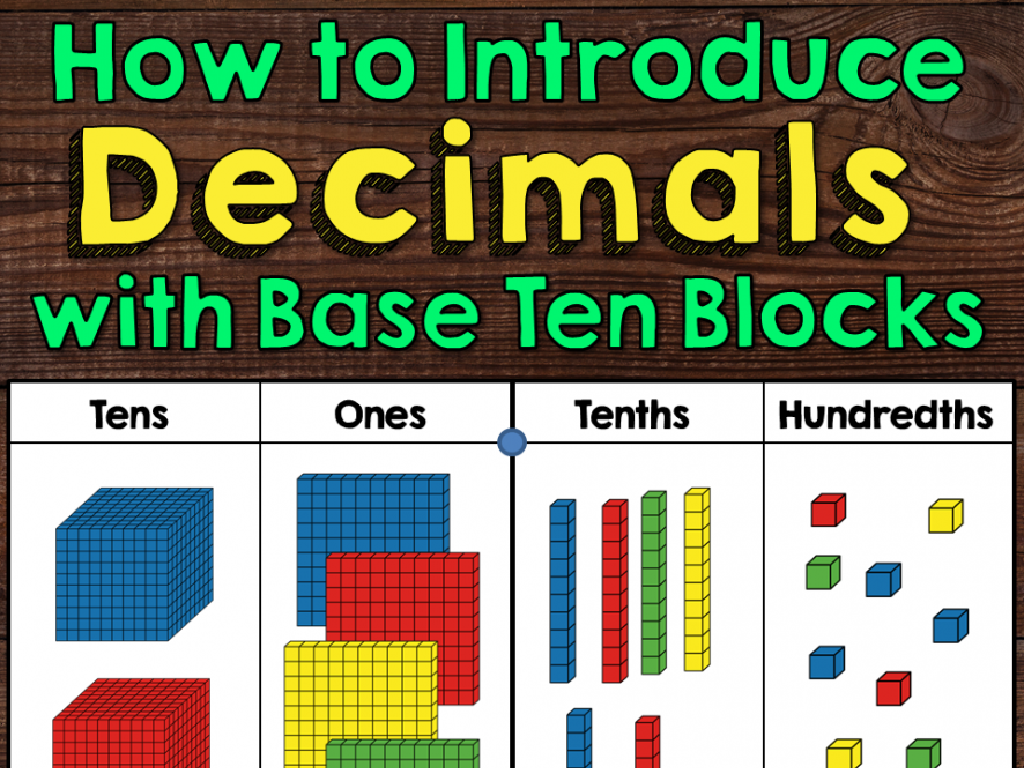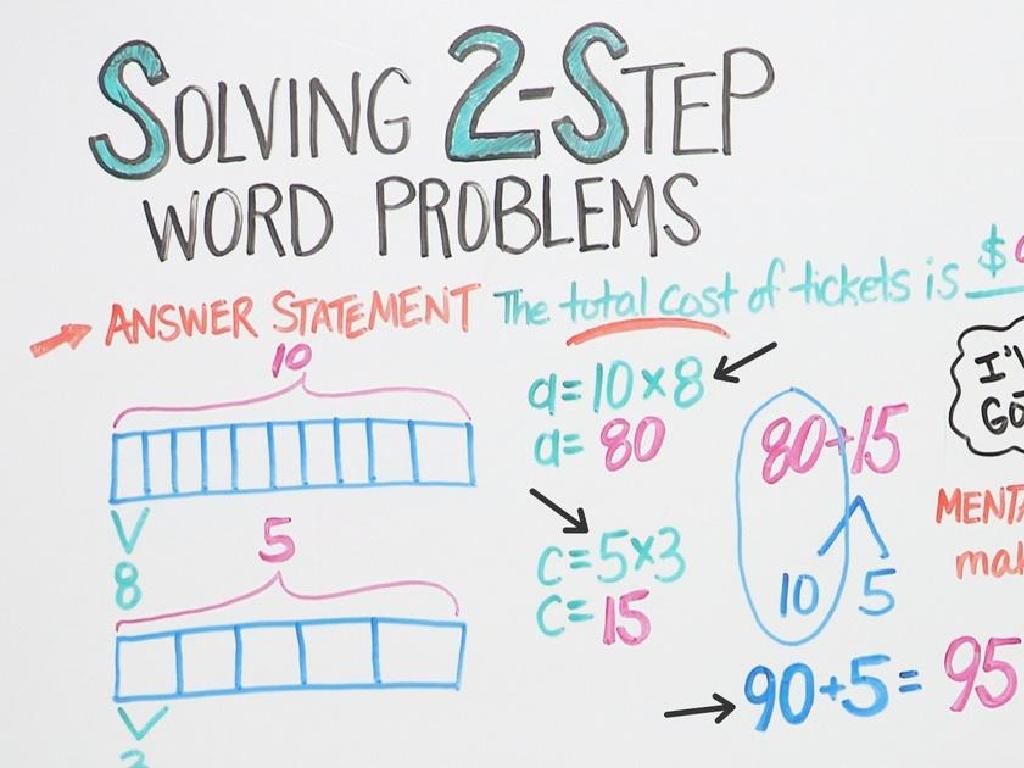Count The Number Of Squares In A Rectangle
Subject: Math
Grade: Second grade
Topic: Area And Tiling
Please LOG IN to download the presentation. Access is available to registered users only.
View More Content
Exploring Area with Square Tiles
– Greet the day and get ready for math
– Counting squares in rectangles
– Each square inside a rectangle is one ’tile’ of area
– Area helps with real-world tasks
– Like figuring out how many tiles for a floor
– Practice makes perfect with tiling
|
Begin the lesson with a warm welcome to set a positive tone for the class. Introduce the concept of area as the number of square tiles that can fit inside a rectangle. Explain that understanding area is not just a math skill but a practical one too, such as when determining the number of tiles needed to cover a floor. Encourage the students to visualize the process by imagining laying down tiles on a floor, one by one, to cover the entire surface without gaps or overlaps. Provide hands-on activities where students can practice counting squares within various rectangles to reinforce the concept. This will help them grasp the idea of area in a tangible way.
Exploring Area: How Many Squares Fit?
– Area is the size of a surface
– Imagine fitting tiles in our classroom
– How many square tiles cover the floor?
– Area is measured in square units
– Like square inches (in²) or square feet (ft²)
– Practice with counting squares
– Let’s count squares in different rectangles
|
This slide introduces the concept of area to second-grade students in a tangible and relatable way. Begin by explaining that area is the amount of space inside a shape. Use the example of tiling a classroom floor to make it concrete for the students. Show them that area is measured in square units, which could be related to tiles on the floor. Each tile represents one square unit. Encourage students to visualize and understand that we can use these square units to measure the entire space a shape covers. To reinforce the concept, engage the students in an activity where they count the number of squares that fit inside various rectangles drawn on paper or the board. This will help them grasp the idea of area measurement in a practical and interactive manner.
Counting Squares in a Rectangle
– A rectangle’s area with squares
– Imagine a rectangle as a big box filled with little square boxes.
– Count squares to find area
– Like counting tiles on a floor to know how many fit!
– Each square is one square unit
– One square unit is like one tile on the floor.
– Practice with different rectangles
– Try counting squares in rectangles of different sizes.
|
This slide introduces the concept of area through the visual and tangible method of counting squares within a rectangle. Explain that area is the size of a surface and can be measured by counting the number of square units that fit inside a shape. Use simple, everyday examples like tiles on a floor to make the concept relatable. Encourage students to practice by drawing different-sized rectangles on graph paper and counting the squares. This hands-on activity will help solidify their understanding of area as a measure of space within a boundary.
Let’s Count Together: Squares in a Rectangle
– Observe the rectangle with squares
– Count each square inside the rectangle
– Understand each square as one unit of area
– A square unit is a measure of area, like a tile on the floor.
– Practice counting with classmates
– We’ll count as a group to learn together!
|
This slide is designed to introduce second-grade students to the concept of area through a hands-on counting activity. Display a rectangle with a clearly defined number of squares inside. Guide the students to count each square, reinforcing the idea that each square represents one square unit of area. Emphasize that area is a measure of space inside a shape, similar to how many tiles can fit on a floor. Encourage the students to work together to count the squares, fostering a collaborative learning environment. This activity will help them visualize and understand the concept of area in a tangible way.
Counting Squares in a Rectangle
– Count squares row by row
– Start at the top row, count each square until the end
– Ensure no square is missed
– Counting each row helps keep track of all squares
– Count like reading a book
– Move left to right, top to bottom, like reading
– Practice with a rectangle
– Use a rectangle to apply what we’ve learned
|
This slide is designed to teach second-grade students how to count the number of squares within a rectangle by using a methodical row-by-row approach. This technique is similar to reading a book, which is familiar to them, and it ensures that they do not miss any squares. Encourage the students to start at the top left corner and count each square one by one until they reach the end of the row, then move down to the next row and repeat the process. This method helps in organizing their counting and reinforces the concept of area as a measure of space covered by the squares. During the class, provide rectangles with different numbers of squares and have the students practice this counting method. This hands-on activity will help solidify their understanding of the concept.
Counting Squares: Column by Column
– Count squares column by column
– Ensures all squares are counted
– Imagine climbing a ladder
– Start at the bottom, count up to the top
– Practice with a rectangle
– Let’s count together in class!
|
This slide introduces an alternative method for counting squares within a rectangle, which is by counting column by column. This method helps to systematically ensure that all squares are accounted for, much like climbing a ladder rung by rung. It’s a visual and methodical way to approach the problem, which can be particularly helpful for second graders as they learn to visualize and count in an organized manner. During the class activity, provide students with a rectangle divided into squares and guide them to count the squares in each column, starting from the bottom and moving to the top. Encourage them to check their work by comparing with their peers and discuss any discrepancies to reinforce the concept.
Practice Time: Counting Squares in Rectangles
– Count squares within rectangles
– Record each rectangle’s area
– Write the total count as area in square units
– Area equals number of squares
– Remember: Area is the total space inside the shape
– Share your findings with the class
|
This slide is an activity for students to apply their knowledge of counting squares to find the area of rectangles. Provide students with graph paper featuring rectangles of different sizes. Instruct them to count the number of squares within each rectangle and write down the area in square units. Emphasize that the area of a rectangle is the total number of squares that cover the space inside it. After completing the activity, students should be prepared to share their results and discuss any challenges they faced. Possible activities include counting squares in rectangles of varying sizes, using colored pencils to outline each square unit, or pairing up with a classmate to compare answers and methods.
Class Activity: Tile the Paper
– Create tiled rectangles with paper squares
– Use colorful paper squares to make a rectangle
– Cover your rectangle completely
– Make sure there are no gaps or overlaps
– Count the squares to find the area
– Each square represents one unit of area
|
This activity is designed to help second-grade students understand the concept of area through a hands-on tiling exercise. Provide each student with a set of paper squares and a rectangular outline on a sheet of paper. Instruct them to cover the rectangle completely with the squares, ensuring they understand that the squares should not overlap and there should be no gaps. Once they’ve tiled their rectangle, they should count the total number of squares used, which represents the area of the rectangle. Possible variations of the activity could include using different-sized squares or comparing rectangles with the same perimeter but different areas. This will help students grasp that area is a measure of space within a shape.
Fantastic Square Counters!
– Celebrating our square counting
– Understanding rectangle area
– Area is the space inside a rectangle
– Area equals square units
– Like tiles on the floor, each square is one unit
– Keep practicing at home!
– Try counting squares in floor tiles or windows
|
This slide is meant to congratulate the students on their hard work during the lesson and to reinforce the concept of area as it relates to counting squares within a rectangle. Emphasize that area is always measured in square units, which can be visualized as the number of square tiles it would take to cover a surface. Encourage the students to continue practicing by counting squares in everyday objects around them, such as floor tiles or window panes, to further solidify their understanding. Remind them that practice is key to becoming comfortable with finding the area of various rectangles they may encounter.






